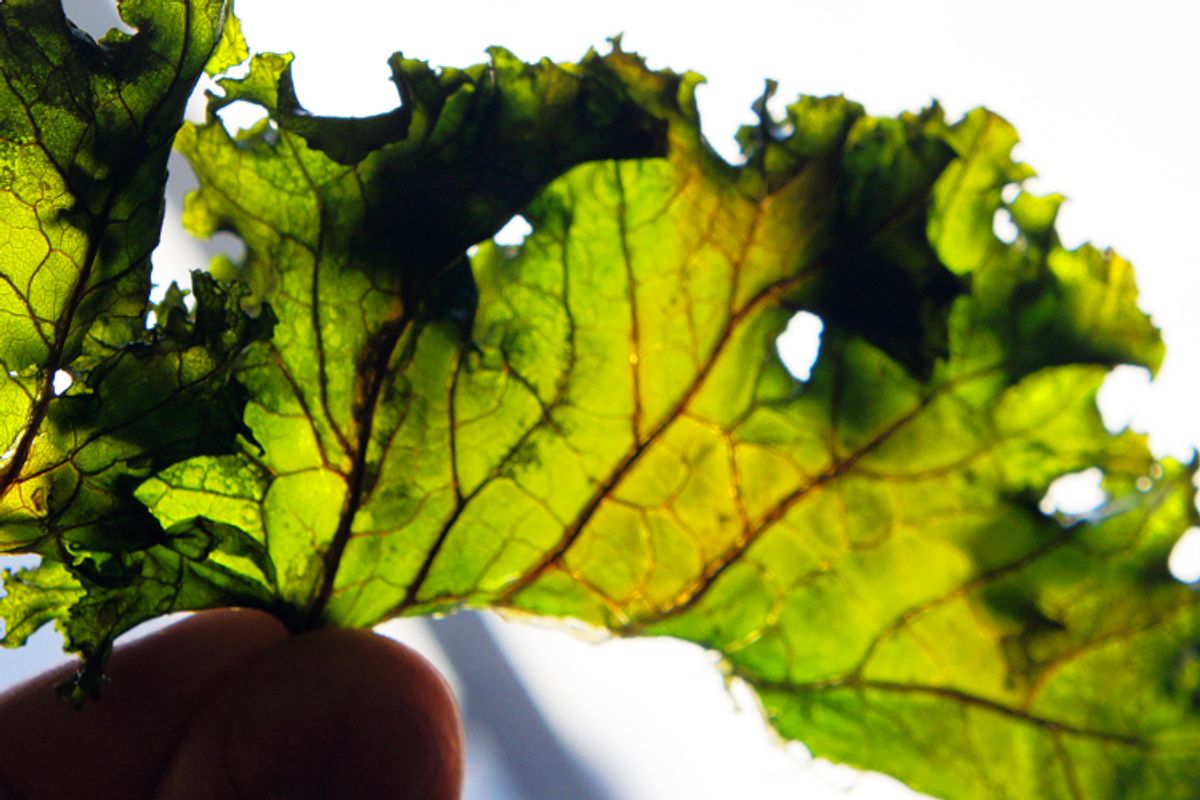It's been decades since the time in my life when I wore T-shirts with slogans and names of bands, but I do have two still kicking around my dresser. One is pure rock 'n' roll, and the other says, "Eat more kale."
I get that kale can be a tough sell. It's been maligned for decades, in a nation not known for its love of vegetables, as a deeply unreconstructed vegetable. Scary-dark green, way tougher than lettuce and vaguely bitter, it was long relegated to being a frilly little decoration on fruit plates and supermarket fish counters. My best friend, in fact, grew up working a part-time job at a supermarket fish counter. He was 24 when he found out you can actually eat the stuff he used to tuck into the ice around the salmon steaks.
But kale lovers ... oh, we know. We know all about its superfood properties: 36 calories-worth of it contains five grams of fiber, 15 percent of the daily requirement of calcium and vitamin B6, 40 percent of magnesium, 180 percent of vitamin A, 200 percent of vitamin C and 1,020 percent of vitamin K. And that's before we get to the copper, potassium, iron, manganese and phosphorus.
OK, call my bluff. I don't know what any of those things do for you. Let me tell you what I do know. The leaf is full of flavor, wallops of chlorophyll green goodness. Cooked quickly, its springy chewiness is intensely satisfying; braised tender, it still has enough body to hold up in soup or stew. The Portuguese stir thinly shredded fistfuls of it into basically what is potato and sausage broth to made their national dish, caldo verde. Brazilians sauté it in ripping hot oil with garlic to serve with their national dish, feijoada. I like to sauté it in garlicky oil and toss it with toasted nuts, some cheese, a splash of vinegar or lemon and pasta (OK, fine, and a little bit of butter) for a quick, lovely dinner.
And then there's this: the kale chip. Kale chips were the hotness on the food blog circuit a couple of years ago, but honestly I never got around to making them because I never grew tired of kale as-is. But I did get around to it, and I can't say that I am happy that I waited so long.
The idea behind these chips is simple -- baked at low heat, rubbed down in oil, leafy greens become crisp and impossibly light. You're not really roasting them -- you're really just dehydrating them. What comes out is three shades darker, mottled beautifully with almost black, glassy spots. They're pure crispness, a brief crackle that disintegrates and disappears, leaving just a mouth-filling vegetal flavor -- minerally, deep green and roasty, almost mushroomy.
Not that you'll forget about potato chips, but these wouldn't be out of place in a bowl next to them. Or crumble them into an intriguing topping or seasoning for anything that could use a punch of complex, "what was that?" flavor.
Finally, for some, these may be a great introduction to the glories of kale, or for others who are scared of the flavor of leafy greens, they might be a little intense. For those in the latter camp, you can also make these with spinach or baby spinach, which comes out much sweeter and lighter.
Kale or spinach chips
Ingredients
- Kale, curly or flat (aka Tuscan, lacinato or dinosaur), or spinach
- Olive or other kind of oil (lightly garlic-infused oil if you're fancy)
- Salt
- Smoked paprika or other spices, if you're really fancy, optional
Directions
- Preheat your oven to 275 degrees.
- If using kale, hold the thick stem between two fingers and strip the leaf from the stem; if the stem is thick through the middle of the leaf, it's better to strip it so the leaf comes apart in two pieces. If using spinach, do the same if the stem is thick. Baby spinach leaves are fine as they are.
- Toss the leaves with a splash of oil, enough to lightly coat, not drown them. If you're using kale, give the leaves a nice rub with your fingers to get the oil all over them. Season lightly with salt (as the leaves dehydrate, they'll shrink, so the chips will taste much saltier than when they go in).
- Lay leaves flat on a baking sheet; don't overlap them, but they can be close to one another. Bake until they're dried, crisp and crackly with no chewiness left, about 26 minutes for curly kale, 24 for flat kale, 18 for spinach or 15 for baby spinach leaves. In any event, be sure not to bake them for too long, lest they brown and get too intense.
- Once they're done, you can lightly sprinkle them with spices. Store in an airtight container.



Shares